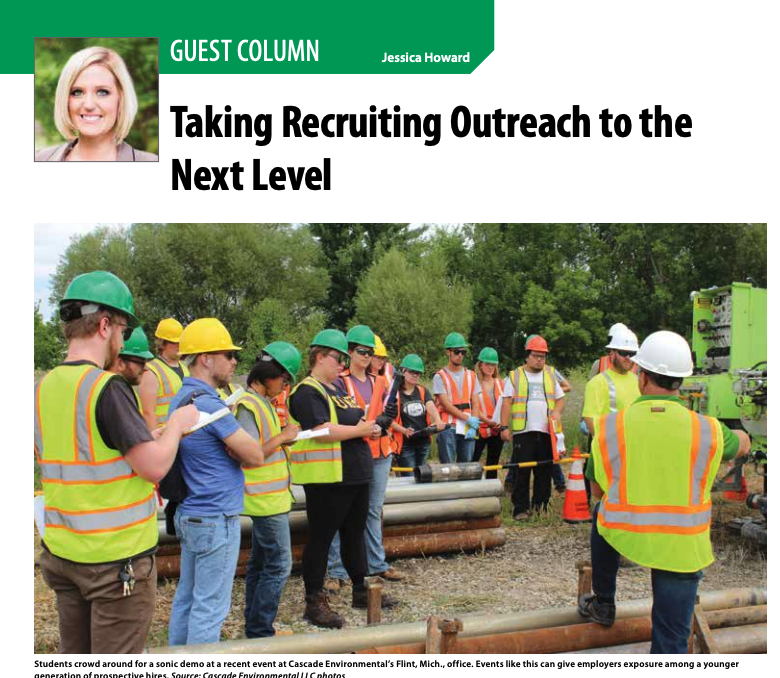Diversity Isn’t Enough: Why Inclusion Matters for the Environmental Services Industry
By: Jessica AlexanderBuilding a diverse workforce is critical to the environmental services industry. In previous articles, I’ve explained why it’s important and how to attract employees from diverse backgrounds.
But once you’ve recognized the importance of recruiting a diverse workforce, the next step is to build a work environment that makes your employees want to stay—an inclusive culture that promotes employee satisfaction, productivity and retention. This article will provide a commonsense approach and best practices for how your organization can start building a more inclusive workplace for all employees.
What is the difference between diversity and inclusion?
Before we jump in, it’s important to know the difference between diversity and inclusion. While they should go hand-in-hand, they aren’t the same thing.
Diversity refers to your employees and their ethnic, racial, socioeconomic, religious and cultural backgrounds. When you have a diverse workforce, you have employees from a wide variety of backgrounds, which means your company has the potential benefit of hearing a range of perspectives and ideas that can make your business stronger.
Inclusion is about making your employees from diverse backgrounds feel welcome in your organization, and like they can speak up, fully participate, earn promotions, and be treated as equal and valuable members of the team. A company’s policies and culture can encourage inclusion—or they can help reinforce the “default” perspectives of the majority, making it difficult or uncomfortable for people who don’t belong to that group to participate.
Why does an inclusive culture matter?
Imagine working in an organization where…
- No one celebrates the same holidays as you, so you often can’t get them off from work.
- Your coworkers never learn to pronounce your name correctly.
- In meetings, your perspective isn’t requested or is regularly dismissed, so you stay quiet even when you have something important to share.
- People comment about you “always being sick”—calling the group’s attention to something you would prefer to keep private.
Most of us would not feel valued in a workplace where our differences from the default norm were regularly working against us. Organizations that prioritize inclusivity work to ensure employees’ differences are valued as strengths, people of all backgrounds feel welcome, and everyone can contribute to their full capabilities.
This matters because inclusive work environments are ones that inspire employees’ best work as well as their loyalty—increasing productivity and reducing turnover. According to a recently released paper from Gallup, when we’re able to retain our best employees and a diverse workforce, we see benefits that more directly impact our bottom line, like…
- Increased innovation
- Better communication with customers
- Improved sales
- Higher financial performance
What kind of inclusivity goals can be set? And how do you measure them?
If you currently don’t have a diversity and inclusion program, here are a few measurable goals you may want to consider for launching your efforts.
- Education and training. Make sure that everyone in your company—from the CEO down to the newest assistant driller—shares the same baseline understanding about diversity and inclusion. There are many training programs for you to choose from (here’s a guide for selecting one that’s right for you company). Make this part of the onboarding process for new hires, and incorporate it into annual training schedules to ensure the information stays fresh for everyone.
Most online training platforms provide data about who has completed the program, which would provide an easy way for you to measure whether or not you’ve met your training goals for the year. - Benefits adjustment. People from diverse backgrounds may require different benefits, such as religious holidays off from work. If this is a step your company would consider, we’ve outlined a process for identifying the benefits your workforce most wants.
Annual anonymous employee surveys can help you determine what updates your employees really want to their benefits package, and can measure their level of satisfaction with the efforts you’ve already undertaken. - Diverse recruitment and hiring. Commit to expanding your recruitment and hiring efforts to include a more diverse candidate pool. Be transparent and concrete about what constitutes success—and what your actual annual performance in this area is. At Cascade, we report our hiring breakdowns in our annual corporate sustainability report, allowing our employees and our clients to see what we’ve accomplished and where we still have room to improve.
For this effort to be effective, you may need to start with an employee census so you have baseline data to use for building your goals. From there, your HR staff should be able to track whether or not you’re hitting your recruitment and hiring goals.
Not all goals are easily measurable, but that doesn’t mean they shouldn’t be encouraged.
Gallup studied more than 200 organizations and reviewed relevant academic research to identify three common elements that contribute to an inclusive environment for employees. They found that an inclusive environment is one in which…
- Employees are treated with respect
- Employees are valued for their strengths
- Leaders do what is right
One would be hard pressed to quantify how much more leaders are “doing what’s right” one year over the next, but these are still values and goals that can become part of your company’s culture. To encourage these behaviors, you may consider establishing peer recognition programs, a change in annual evaluations, or some other effort specific to your organization. Whatever you do, find ways to connect your values related to inclusion to the way your business operates.
Who should be involved in company inclusion efforts?
Ideally, everyone.
To develop a truly inclusive workplace culture, all employees within the company need to be involved. Leadership support is instrumental in driving diversity and inclusion efforts at the corporate and structural levels, but employee commitment and change are what transform the workplace experience for everyone.
You can start by surveying your employees and asking for their input. What kind of changes do they feel are most important? What level of involvement do they want to have?
Allow their feedback to guide how you structure the company’s response—whether there is an employee-led advisory committee, annual reporting by HR, an executive sponsor charged with developing and running the program, all of the above or something else entirely. Not only does this give your organization the opportunity to act on what’s most important to your staff, it also promotes buy-in on resulting initiatives.
There will be skilled labor shortages in our industry in the next decade if we don’t continue to improve our recruitment and retention efforts. That means we need to lay the groundwork today, making this an open, welcoming industry to work in for people of diverse backgrounds. It means as individual companies, we must identify how to make our policies and cultures more attractive and inclusive. Hopefully, you now feel prepared to take the first few steps in that direction.
If you still have questions, feel free to reach out to me at [email protected]. I’d be happy to chat about how we can work together toward a more inclusive environmental services industry.
ABOUT THE AUTHOR

Jessica Alexander, SHRM-SCP
DIRECTOR OF TALENT ACQUISITION
[email protected]
Jessica Alexander is the Director of Talent Acquisition for Cascade Environmental, LLC. She holds a B.S. in Human Resource Management, B.S. in Business Administration, MBA, and Doctorate of Philosophy (ABD) in Human Resource Management. After completing ten years of military service in the United States Air Force in the Logistics and Transportation Management field, Jessica launched a distinguished career specializing in recruiting and talent development. She is passionate about the development of people and their ability to drive companies forward.






